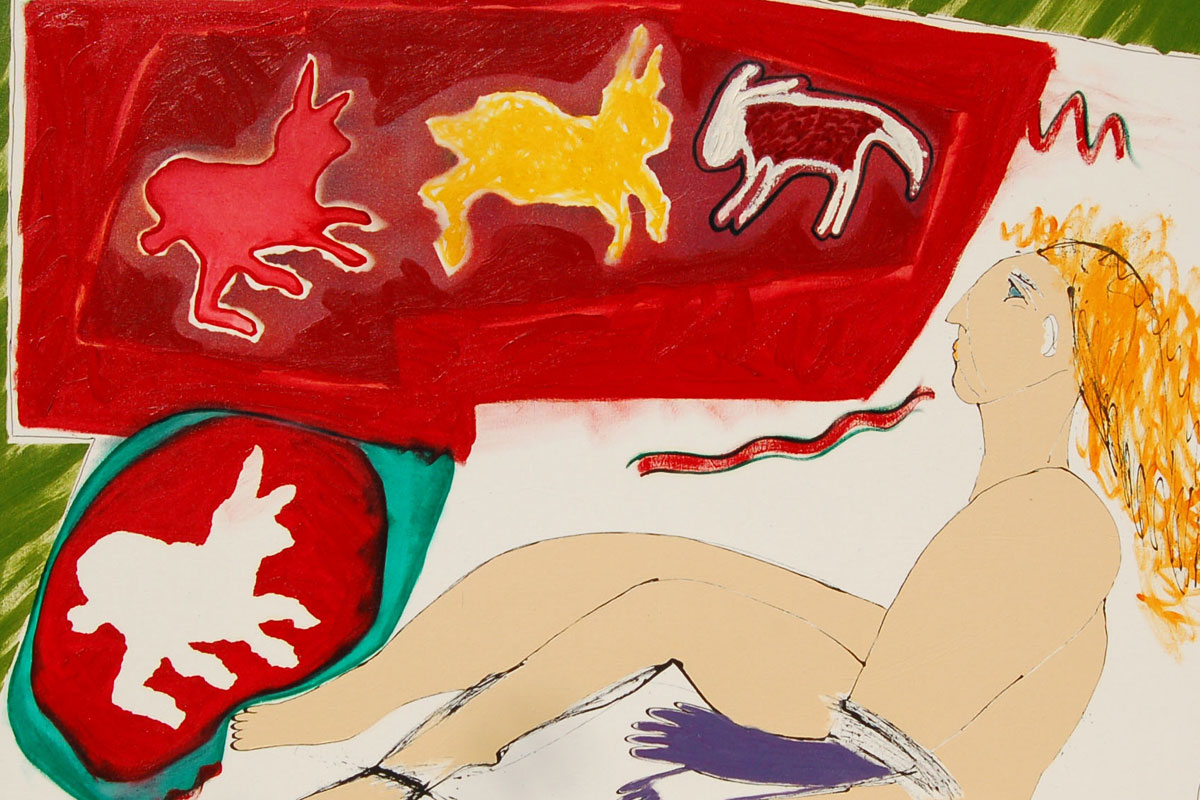 When asked for a statement about my art work,
When asked for a statement about my art work,
my first response is that the art "is" my statement.
It speaks for itself.
Raised in a large family, I found my voice and expression through my hands and visual impressions. My wish is that the viewer opens their visual thoughts and emotions when experiencing my work.
The key people in the support of my career are Irving A. Goldberg; William V. Dunning, Art professor. LaMar Efaw, Interior Designer, Seattle, WA. Antoinette Kraushaar, Kraushaar Galleries, New York, NY and Linda Farris, Linda Farris Gallery, Seattle, WA. All have noted my unique imagery and surface quality using color and texture.
Included are two press reviews that captured my spirit and feelings with their response.
 Figures are facts in Farris show
Figures are facts in Farris show
by Deloris Tarzan, The Seattle Times
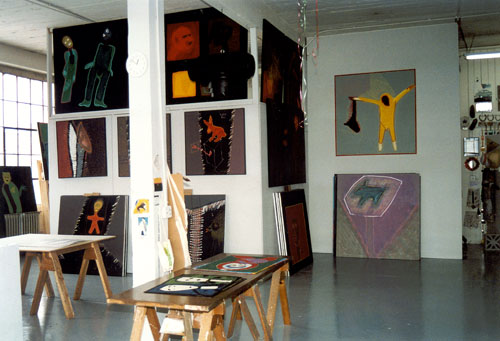 Louise Hoeschen comes on stronger all the time. Every work of art is a fiction; a fantasy endowed with the power not only to co-exist with the real people and objects of the world, but to modify in some degree the way we perceive them.
Louise Hoeschen comes on stronger all the time. Every work of art is a fiction; a fantasy endowed with the power not only to co-exist with the real people and objects of the world, but to modify in some degree the way we perceive them.
Modern painting has brought this fictive element to a high degree of self-consciousness. It has done so, paradoxically, by declaring the unequivocal reality of its own artifice. Nothing is more characteristic of modernist art than its radical insistence on shedding all disguises. Ms. Hoeschen has tapped into just this painterly approach in her show at the Linda Farris Gallery.
Drawing simplified to the contours of a silhouette, larger areas, heavy saturations of unbroken color, and images reduced to a single plane — those are the salient features of her pictorial syntax.
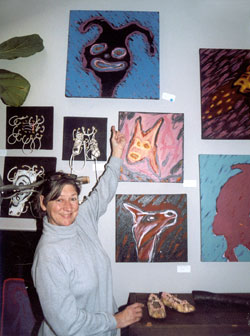 A LINE-DRAWN figure moves whitely across a field of color in some works. In others, orange surges against green in the faces and figures or women alone, or women with men.
A LINE-DRAWN figure moves whitely across a field of color in some works. In others, orange surges against green in the faces and figures or women alone, or women with men.
Paint is worked in finger-wide swaths down a nose, across cheeks, circling mouths and eyes, and following the curls of a coif. Each fingernail stands out in a different Easter egg of color, adding to the Aubrey Beardsley suggestion of decadence.
The paintings have a high erotic content. The suggestion of anecdote is implicit in each work. The viewer is supplied with vividly rendered characters and scenery of a situation he is free to devise for himself. Folded hand clipped from a slick magazine collaged into a painting add to the dreamlike verisimilitude of of objects and people to induce daydreams of imaginary episodes.
 Animals in an artist's fantasyland
Animals in an artist's fantasyland
by Ron Glowen, The Everett Herald
Louise Hoeschen's new paintings in her third solo exhibit at the Linda Farris Gallery in Seattle can be described accurately in one word — vivid.
The large, nearly square canvases fill one gallery chamber and an anteroom; mixed media drawings line the walls of an adjoining space. Entering the room of paintings transports the viewer into a dreamlike realm of fantasy populated by solitary figures with groups of animals.
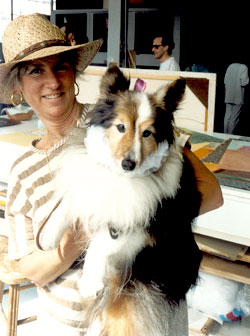 This is not a space-age fantasy or science fiction. "I like the earthy fantasy of animals" says Hoeschen, a Bellevue resident. The interaction of the domesticated animals (often dogs, but cats, chickens, pigs and lambs, too) depicted with the figure suggest a childlike relationship of equanimity rather than a more rational, adult dominance.
This is not a space-age fantasy or science fiction. "I like the earthy fantasy of animals" says Hoeschen, a Bellevue resident. The interaction of the domesticated animals (often dogs, but cats, chickens, pigs and lambs, too) depicted with the figure suggest a childlike relationship of equanimity rather than a more rational, adult dominance.
Hoeschen asserts, "Humans are animals, too, and there an element of denial" involved, so the artist reaches into the subliminal to bring out the truth.
Truth in vision, or in depiction? Well, no — the fantasy landscape is devoid of boundary and spatial references of shadow, dimension and scale. Dogs are green or blue, boys are solid red and brown cats are outlined in vibrant, pulsating yellow.
Repetitive slashes of paint atop a flat color base and the jarring juxtapositions or intense color fields promote the abstraction of forms. With the dearth of visual cues, only our awareness of the forms allows us to perceive them as animate and recognizable. The truth is sought, not in visual memory, but in the recesses of the mind.
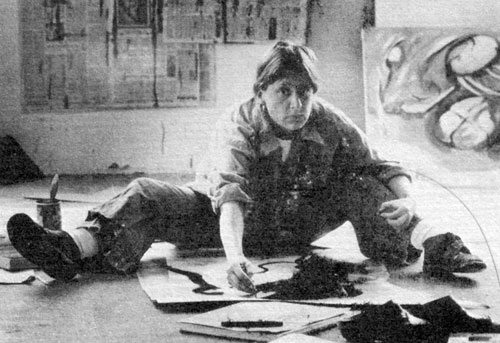 The vivid colors complement the vividness of the images that, for all their reference to common domestic creatures, remains a mental rather than a purely visual scene. In this image state, situations involving the figure and animals assume a heightened meaning. A running figure, perhaps a child, frolics in the close companionship of his pet dogs.
The vivid colors complement the vividness of the images that, for all their reference to common domestic creatures, remains a mental rather than a purely visual scene. In this image state, situations involving the figure and animals assume a heightened meaning. A running figure, perhaps a child, frolics in the close companionship of his pet dogs.
In another work, "Doin' the Cat Steps," the figure and three cats regard one another with detached aloofness — emotion gives way to diffidence. Reality mixes with dreams in "Walk Sleep Stand," wherein the animals circle a twisted, seemingly anguished figure like mental projections from a nightmare. The image is directed back to its source.
Hoeschen's intelligent awareness and understanding of the conscious and subliminal relationships between humans and animals is evident, in spite of the apparent "dumbness" of the graphic technique. An adult might wonder what green chickens mean, but a kid would understand.
